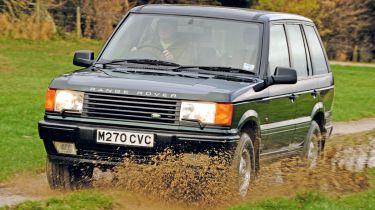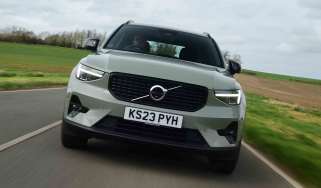Range Rover Mk2
Second generation turned up luxury and refinement, yet retained rugged ability
How do you replace a legend? If you’re Range Rover, then you make sure you don’t mess with a winning formula. The huge popularity of the Vogue special editions proved that the demand for luxurious 4x4s was growing. To meet those expectations, the second-generation Range Rover aimed to deliver a big leap forward in terms of quality and refinement, while retaining the old car’s character.
Design director George Thomson was handed the responsibility of creating a fresh look for the new car, which was codenamed P38A. Exotic proposals from Italian styling houses Bertone and Pininfarina were considered, but his team’s Pegasus concept was declared the winner after a rigorous series of customer clinics.
Iconic family styling cues such as the blacked-out C-pillars, floating roof and ‘castle’ ridges along the bonnet were all retained. Yet despite its conservative image, this new shape was vastly more aerodynamic than its slab-sided predecessor. This drastically reduced wind noise, and combined with a new four-speed automatic gearbox to make the Range Rover a quiet and comfortable cruiser.
But the biggest changes were reserved for the cabin, which shared only its plush carpets and wooden inlays with the Classic. The vintage seventies interior was overhauled and replaced by a modern dash that added luxuries such as a multifunction steering wheel, while the driving position was far more car-like than before.
Used - available now

2020 Land Rover
Range Rover
55,504 milesAutomaticDiesel3.0L
Cash £35,323
2020 Land Rover
Range Rover
64,548 milesAutomaticDiesel4.4L
Cash £30,346
2018 Land Rover
Range Rover
62,853 milesAutomaticDiesel3.0L
Cash £29,828
2026 Land Rover
Range Rover
5,312 milesAutomaticDiesel3.0L
Cash £107,589Hidden under its evolutionary styling, the new Range Rover carried over much of the Classic’s heavy-duty off-road engineering. However, the latest 4.6-litre Rover V8 now produced 225bhp and a healthy 380Nm of torque in the flagship HSE model. It retained the warbling soundtrack of the original 3.5-litre petrol, but the crude, Italian-made VM Motori diesel was ditched in favour of a straight-six sourced from BMW – which had completed its takeover of Rover by the time the P38A went on sale in 1994.
Taking the Range Rover off-road was now even easier thanks to the H-pattern gearshift, which allowed the driver to switch between the high and low ranges with ease. The standard air-suspension was programmed to automatically lower the car at speed to improve stability, but it was also capable of rescuing the situation when grounded off-road by pushing the wheels down until they lifted the car. This system could even be manually adjusted at the touch of a single button on the dash.
The steel ladder-frame chassis was made stiffer and heavier than before thanks to new welding techniques, but it shared its 2.74m wheelbase with the final-run LSE version of the Classic. Common-sense updates such as moving the spare wheel under the boot floor and putting the fuel tank below the rear seats helped to improve crash safety. Meanwhile, engineers made the new car even more secure by strengthening the door beams and boosting the traction control to cover all four wheels.
Our test of the two back-to-back on a muddy hillside was revealing. The MkII is much easier to drive thanks to its lighter steering, and there is plenty of travel in the throttle before the engine surges into life. Over rough ground the ride is still firm and well below the standard of the later cars, but even after 18 years it feels sturdy enough to tackle every obstacle.
As a testament to its off-road ability, the car in our pictures was used during the Range Rover’s worldwide launch in September 1994. It was driven by Viscount Linley from downtown Tokyo to Mount Fuji in Japan – a feat that was then beamed via satellite to dealerships across the globe full of eager prospective customers.
The first ‘modern’ Range Rover may have been a careful evolution rather than a total mechanical overhaul, but it cemented the brand’s new premium positioning and introduced many of the luxury features that we now take for granted on the latest models. Its success was also enough to convince then-BMW boss Wolfgang Reitzle to speed up the development of its hi-tech replacement: the L322.



